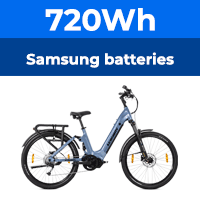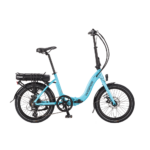One last try, and then 1`m out too!
My interest in this thread went like this-
Current approaches by manufacturers and suppliers give confusing and inconsistent advice regarding range
(I posted an example where the same Wisper 905se 14Ah Sport was quoted with four different ranges on four different dealer websites, never mind comparison between brands we dont even have consistent advice regarding individual bikes)
So, perhaps the trade association along with leading manufacturers and dealers could come up with a standard means of testing so all can agree a fair and reasonable approach - lets have an on line debate about setting a standard. I joined in and watched.
Oh the niaivety of the new enthusiast! I had much to learn, certain systems are way more sophisticated than I ever imagined, comparisons with other purchases dont stack up and its a battle all round. The exasperation of it all, added to the fact that many of the senior members have probably seen it all before!
So, setting a standard seems potentially too difficult, too controversial, and maybe too expensive. I can see that now, it dissappointing, but the perfomance of hybrid means of transport certainly adds a new dimension. My recent commutes have shown me just how much variation I have on the same bike, same route depending on my mood, effort and enthusiasm. I now accept the arguments regarding how difficult this is.
But, the problem remains. On most dealer websites there is a spec list for each bike. Spot the odd one out - seat post, rims, tyres, lights, range, brakes, gears, etc. I`m used to internet shopping and detailed spec lists. I`m used to stated specifications being just that. The current approach to "sneaking" the range figure in with a detailed list of other items I can touch, feel and verify is what I object to - it gives the impression its a statement of fact like the make of tyre or number of gears, but its not - as we have been discussing - its way more complex than that.
So, a suggestion, if its so hard to agree a fair way to state range, then dont.
Simple, - dont do it at all as part of your spec lists - its not part of the spec!
Let buyers concentrate on what gears the bike has, mudgurads, suspension, brakes, warranty, dealer back up etc which are matters of fact. Then, on each BEBA dealer website add a specific link to information regarding batteries and range. Give the customer clear and fair advice about what different types of battery, sizes of battery, ways to use the battery (throttle, pedelec, hub or crank), and riding styles will impact on battery range. Within the spec lists refer to the battery link for information. Same information on all BEBA dealer websites, covering all makes of bike, all current sizes of battery, plus advice regarding battery care and lifespan.
(and yes I know some sites already have something similar, but then they confuse this good work by adding a liberal sprinkling of spurious "range guesses" into the spec lists, remember the one bike with claimed ranges of 20-50, 35, 60 and 68 miles depending on where you look)
It may even be possible for the BEBA to draft such a set of advice, consult on the wording (even on here?!) and have something we can all feel is reasonable and helpful. Then lets leave the bikes to speak for themselves; the batteries continue to get bigger and better; and the best advice anyone can recieve to be to try before you buy at your local BEBA approved dealer.
Think thats my two, three and fourpenneth added!
Thanks for reading my babblings
Goodnight
My interest in this thread went like this-
Current approaches by manufacturers and suppliers give confusing and inconsistent advice regarding range
(I posted an example where the same Wisper 905se 14Ah Sport was quoted with four different ranges on four different dealer websites, never mind comparison between brands we dont even have consistent advice regarding individual bikes)
So, perhaps the trade association along with leading manufacturers and dealers could come up with a standard means of testing so all can agree a fair and reasonable approach - lets have an on line debate about setting a standard. I joined in and watched.
Oh the niaivety of the new enthusiast! I had much to learn, certain systems are way more sophisticated than I ever imagined, comparisons with other purchases dont stack up and its a battle all round. The exasperation of it all, added to the fact that many of the senior members have probably seen it all before!
So, setting a standard seems potentially too difficult, too controversial, and maybe too expensive. I can see that now, it dissappointing, but the perfomance of hybrid means of transport certainly adds a new dimension. My recent commutes have shown me just how much variation I have on the same bike, same route depending on my mood, effort and enthusiasm. I now accept the arguments regarding how difficult this is.
But, the problem remains. On most dealer websites there is a spec list for each bike. Spot the odd one out - seat post, rims, tyres, lights, range, brakes, gears, etc. I`m used to internet shopping and detailed spec lists. I`m used to stated specifications being just that. The current approach to "sneaking" the range figure in with a detailed list of other items I can touch, feel and verify is what I object to - it gives the impression its a statement of fact like the make of tyre or number of gears, but its not - as we have been discussing - its way more complex than that.
So, a suggestion, if its so hard to agree a fair way to state range, then dont.
Simple, - dont do it at all as part of your spec lists - its not part of the spec!
Let buyers concentrate on what gears the bike has, mudgurads, suspension, brakes, warranty, dealer back up etc which are matters of fact. Then, on each BEBA dealer website add a specific link to information regarding batteries and range. Give the customer clear and fair advice about what different types of battery, sizes of battery, ways to use the battery (throttle, pedelec, hub or crank), and riding styles will impact on battery range. Within the spec lists refer to the battery link for information. Same information on all BEBA dealer websites, covering all makes of bike, all current sizes of battery, plus advice regarding battery care and lifespan.
(and yes I know some sites already have something similar, but then they confuse this good work by adding a liberal sprinkling of spurious "range guesses" into the spec lists, remember the one bike with claimed ranges of 20-50, 35, 60 and 68 miles depending on where you look)
It may even be possible for the BEBA to draft such a set of advice, consult on the wording (even on here?!) and have something we can all feel is reasonable and helpful. Then lets leave the bikes to speak for themselves; the batteries continue to get bigger and better; and the best advice anyone can recieve to be to try before you buy at your local BEBA approved dealer.
Think thats my two, three and fourpenneth added!
Thanks for reading my babblings
Goodnight








